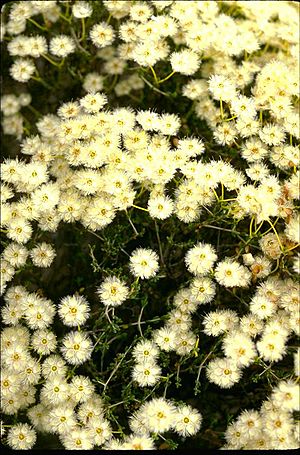Roe's featherflower facts for kids
Quick facts for kids Roe's featherflower |
|
|---|---|
 |
|
| Verticordia roei subsp. roei | |
| Scientific classification | |
| Genus: |
Verticordia
|
| Species: |
roei
|
Verticordia roei, often called Roe's featherflower, is a lovely flowering plant. It is part of the myrtle family, called Myrtaceae. This plant grows only in the south-west of Western Australia. It is a type of shrub with narrow leaves. In late spring, it often gets covered with many creamy-white flowers.
Contents
What Roe's Featherflower Looks Like
Roe's featherflower is a shrub that can grow up to 1 m (3 ft) tall. It usually has one main stem at its base. The leaves on the stems are thin and long, or narrow and oval-shaped. They are triangular when you look at them from the side. These leaves are about 1.5–4 mm (0.06–0.2 in) long and have a rounded tip.
The flowers of this plant have a nice smell. They grow in groups that look like flat-topped clusters. Each flower sits on a straight stalk about 12–20 mm (0.5–0.8 in) long. The floral cup is shaped like half a sphere and is about 1.5 mm (0.06 in) long. It has ridges and is covered with short hairs.
The sepals are creamy-white, but sometimes they can be pink. They are about 6–7 mm (0.2–0.3 in) long. Each sepal has 5 to 7 feathery parts covered with long hairs. The petals are the same color as the sepals and are about 4–5 mm (0.16–0.20 in) long. They are shaped like a dish and have small teeth around their edges. The style, which is part of the flower's reproductive system, is 1–3 mm (0.04–0.1 in) long and has a few short hairs. Roe's featherflower blooms from October to November.
How Roe's Featherflower Got Its Name
The plant Verticordia roei was first officially described in 1838. This description was made by a scientist named Stephan Endlicher. The first plant specimen used for this description was collected by John Septimus Roe. He was the first surveyor-general of Western Australia. The plant's specific name, roei, was given to honor him.
In 1991, another scientist named Alex George studied the Verticordia group of plants. He found that Verticordia roei actually has two slightly different types, which he called subspecies:
- Verticordia roei subsp. roei: This type has stamens (the part of the flower that makes pollen) that are 3–4 mm (0.1–0.2 in) long. Its styles are 2–3 mm (0.08–0.1 in) long.
- Verticordia roei subsp. meiogona: This type has shorter stamens, about 1.5–2.5 mm (0.06–0.1 in) long. Its styles are also shorter, about 1.5–2.0 mm (0.06–0.08 in) long.
Where Roe's Featherflower Grows
This type of verticordia plant usually grows in sandy soil. Sometimes, the soil also has clay or loam, often over a hard layer called laterite.
The subspecies roei is found in many places and is common in areas between Merredin, Boorabbin, Wickepin, Hyden, and Lake Grace. These areas are part of the Avon Wheatbelt, Coolgardie, Esperance Plains, and Mallee biogeographic regions in Western Australia.
The subspecies meiogona grows in a smaller area. It is found near Dalwallinu and Mukinbudin. These places are in the Avon Wheatbelt and Coolgardie bioregions.
Protecting Roe's Featherflower
The subspecies meiogona is listed as "Priority One". This means that it is known to grow in only a few places. These locations might be at risk, so the plant needs special protection. The subspecies roei is not considered to be in danger.
Growing Roe's Featherflower in Gardens
It has been tricky to grow the subspecies roei in gardens or for commercial use. However, people have had more success growing the subspecies meiogona. This type can be grown from cuttings, which are small pieces of the plant. It can also be grown by grafting, where a part of it is joined onto the root system of another plant, like the Chamelaucium uncinatum.

